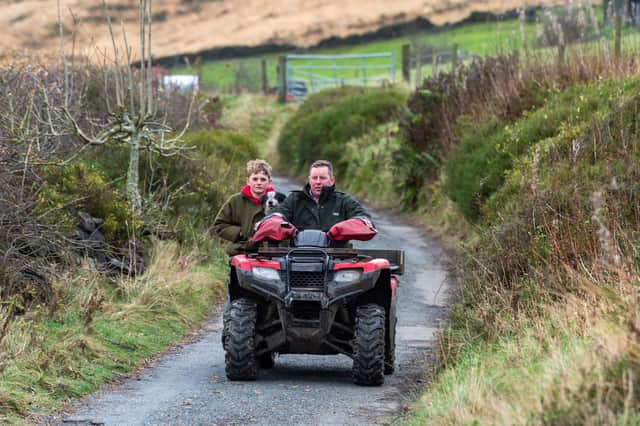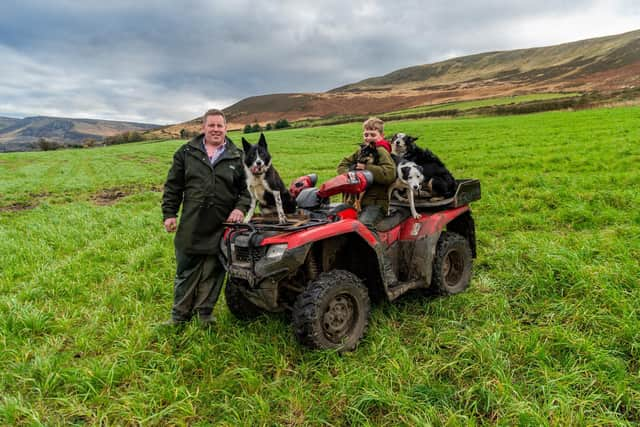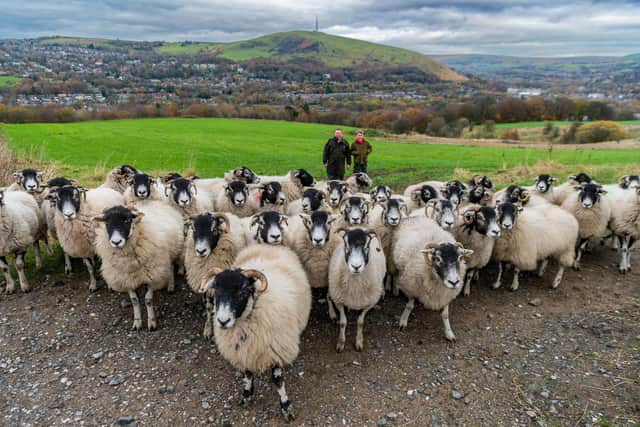Farm of the Week: Young apprentice building up hardy flock on the Pennine moors


William Mullin has a personal pedigree, much like his flock that he has increased from his father’s 150 ewes to 450 in the past two years. His grandfather is renowned sheep farmer and showman Clive Mitchell.
Daniel, William’s father, is delighted his son has already built a reputation around the show and sale rings and pens in Yorkshire, Lancashire and Cumbria and said William is determined to push on with greater ewe numbers and even better quality.
Advertisement
Hide AdAdvertisement
Hide Ad“William has said from being a little boy that he wants to lamb more sheep than one of our neighbours, who lambs around 3,000.


“I’m keen for him to carry on increasing numbers so when he leaves school he has something already in place for himself.
“It’s a joint thing. We work together and it has already gone way past being some kind of a hobby."
Daniel and his wife Jamie, Clive Mitchell’s daughter, have 10 acres at Ox House Farm in Marsden, rent another 100 acres plus moorland and Daniel works as a livestock haulier. He’s always had sheep. His dad, Noel, came over from Omagh in Northern Ireland, settled in Slaithwaite and moved to Marsden where he farms today.
Advertisement
Hide AdAdvertisement
Hide AdDaniel said William is coming up with his own ideas of how to farm the sheep and is forthright with his opinions on what works and what doesn’t.


“We now feed the sheep fodder beet. I was initially against it, but William has been proved right. He decided on sponging the Mules, so that they all come into season together for our early lambing flock in February. That has worked too. Sometimes when I’m unsure of changing something William sets me right. I had never run a Bluefaced Leicester flock up here because I’d always thought they were a little soft for where we are, but William persuaded me we should have them and they have worked.”
William said the pedigree Herdwicks and Bluefaced Leicesters among the 450 ewes are his while the pedigree Lonks are his dad’s, with the Swaledales, Cheviots and all of the Mule crosses shared.
“I’m just trying to better everything. I want better ewes and try to buy better tups to put onto them. If you buy dearer tups you put in better bloodlines.
Advertisement
Hide AdAdvertisement
Hide Ad“Around this time of year my main work is making sure we can get all the tups out in time, so that we can lamb at Easter.
“As soon as I get home from school I’m out checking all around them and on a weekend I’m with them all the time.”
William said he made the decision to go with Herdwicks while he was with his dad at the Great Yorkshire Show five years ago.
“I started with them when dad said to me one summer at the show that I could decide what breed I wanted. I went through every alleyway in the sheep buildings and looked at every breed. The Herdwicks just stood out and looked better than the rest.
Advertisement
Hide AdAdvertisement
Hide Ad“Mum and Dad brought two Herdwick tup lambs back from their anniversary, off someone we know and I bought a gimmer lamb that used to jump in with them from a neighbour. I’ve now built up the pedigree flock to 100 ewes.
“I’ve done well with them up at Cockermouth livestock market where I sold two Herdwick tups for 350 guineas and 250 guineas last year, and I pay good money for my new tups. I bid for all my own sheep.
“I’ve had champion at Hope Show in the any other breed class with a good shearling ewe that made reserve interbreed champion three years ago. It took third in its class at the Great Yorkshire the same year."
William’s Bluefaced Leicester flock runs to 10 ewes, breeding tups to put to the Herdwicks, Lonks and Swaledales to bring the Mule.
Advertisement
Hide AdAdvertisement
Hide AdThe flock of all breeds runs to 100 Lonk ewes, 100 Herdwicks, 50 Swaledales, 10 Bluefaced Leicesters, some Cheviots and the rest either Mules or Texel-crosses.
William said he knows what the Herdwick and Lonk judges are looking for.
“The Herdwick wants to be nice and dark in its fleece, it wants to have some bone in its legs and if it’s a female no horns. It also needs a good mouth, to be clean under its armpits and when showing needs to be clean on its face and front legs, with white on its head, face, legs and armpits.
“Lonks need to have a nice black and white face, half each, also good mouth and no black spots or blue hairs in the fleece. Horns growing well but not into the face, black knees and black down the back legs.”
Advertisement
Hide AdAdvertisement
Hide AdDaniel said the Lonks are more his department but that when it comes to picking show lambs that’s down to William, who also isn’t shy of giving his dad a pep talk.
“I’ve had a reserve breed champion with a Lonk tup at Harrogate and I’ve had a breed champion elsewhere but my results had been going downhill, so William told me I had to up my game and buy better tups.
“We’ve bought a new tup this year, which has cost far too much in my eyes but William said we had to get better.”
The sheep enterprise is now very much a business with father and son together. Daniel said the system they have adopted is a combination of pedigree stock and commercial.
Advertisement
Hide AdAdvertisement
Hide Ad“We now keep the Mule gimmer lambs, run them to shearlings, tup them with the Texel and sell them at Gisburn with lambs at foot. We did that last year and we will do it with more this year.
“We run the Swaledales on Pule Hill due to a relationship we have with a local man. The only snag we have with William’s ambition is that we keep needing more land, but we keep finding more to rent.”
William said he has no intention of slowing down either. “I thought about getting to 4,000 ewes, but when I get to that I still might not stop. I’ve also started shearing. I shear our sheep and for others too like my grandad.”